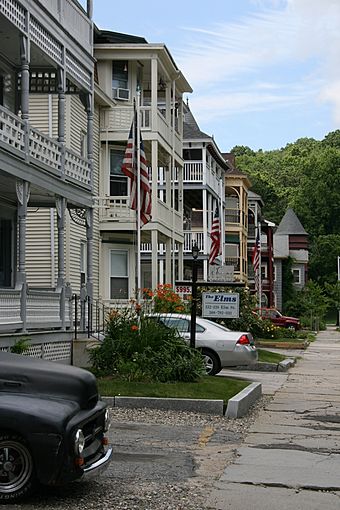Elm Street Historic District (Worcester, Massachusetts) facts for kids
Quick facts for kids |
|
|
Elm Street Historic District
|
|
 |
|
| Location | 132–148 Elm St., Worcester, Massachusetts |
|---|---|
| Area | 1.5 acres (0.61 ha) |
| Built | 1904 |
| Architectural style | Second Empire, Stick/Eastlake, Queen Anne |
| MPS | Worcester Three-Deckers TR |
| NRHP reference No. | 89002374 |
| Added to NRHP | February 9, 1990 |
The Elm Street Historic District is a special neighborhood in Worcester, Massachusetts. It's famous for its beautiful and fancy three-decker houses. These buildings were usually built for working families. But the ones on Elm Street were extra stylish. They were built between 1904 and 1906, right across from Elm Park. This made them popular with wealthier people. This historic area was added to the National Register of Historic Places in 1990.
Contents
Discovering the Elm Street District
For most of the 1800s, the west side of Worcester was a popular place. It was where the city's most fashionable and rich people liked to live. When trolley lines were built, it became easier to get around. This made the area perfect for building nice homes with multiple apartments.
The Story of the Houses
A local real estate developer named Charles Bowker saw this opportunity. Between 1904 and 1906, he built five three-decker houses. These were on the south side of Elm Street, facing the park. The Bowker family lived in one of these homes themselves. The other homes were rented out. They were mostly rented to people with office jobs. This included real estate agents, bookkeepers, and accountants. Other builders also put up similar houses on the same street.
What is a Three-Decker?
A three-decker is a type of house with three separate apartments. Each apartment is on its own floor. They were very common in cities like Worcester. They helped house many families in a growing city. The houses in the Elm Street Historic District are larger than typical three-deckers. They also have more fancy details.
Looking at the Architecture
The historic district covers most of one city block. It runs along the south side of Elm Street. This is between Hudson and Russell Streets. The nine buildings in the district are made of wood. They look like other three-deckers in the city. But they are built on a bigger scale.
Many of these homes have front porches. Some porches stretch all the way across the front of the house. Others even wrap around to the side. Many still have their original, detailed railings. Two houses near the west end of the district are almost identical. They have round corners that stick out. These corners have cool, cone-shaped roofs on top.



